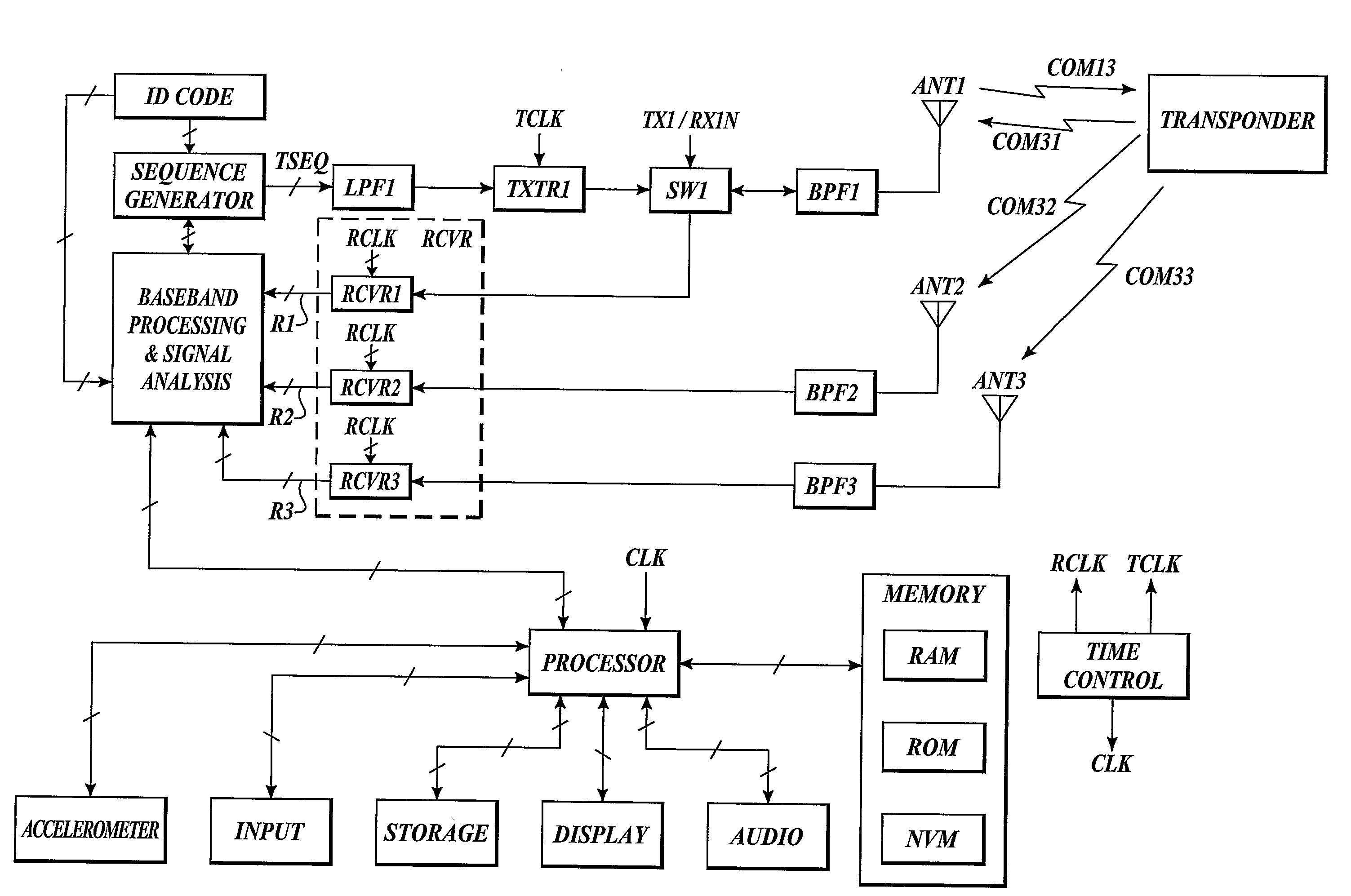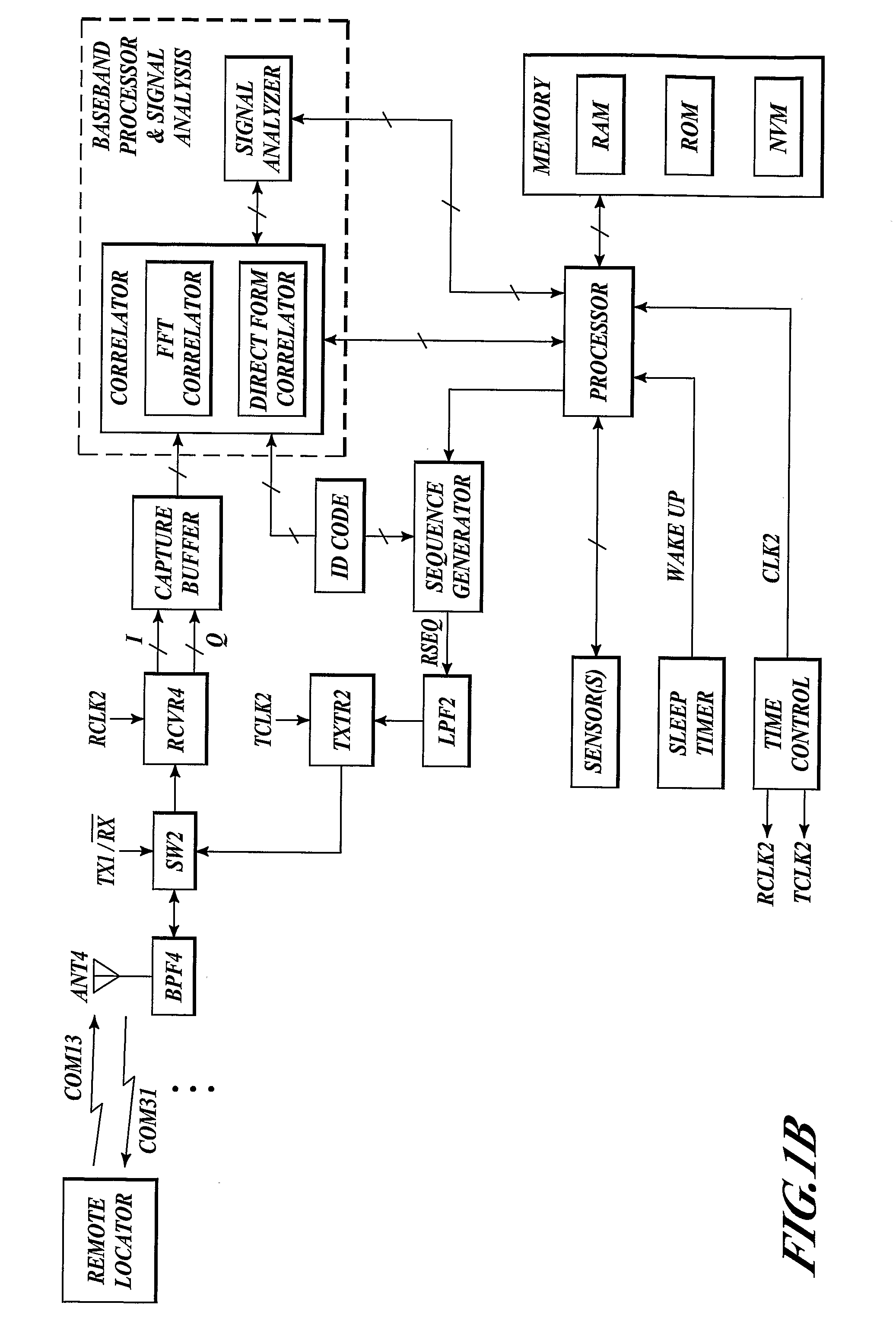System and method for locating objects and communicating with the same
a technology of object and communication method, applied in the direction of direction finders using radio waves, frequency-division multiplexes, instruments, etc., can solve the problems of difficult noise extraction, low power transmission subject to signal corruption, and difficult to extract information from signals in the presence of such interference, so as to increase the signal-to-noise ratio of captured signals and lower levels.
- Summary
- Abstract
- Description
- Claims
- Application Information
AI Technical Summary
Benefits of technology
Problems solved by technology
Method used
Image
Examples
example remote
Locator (RL)
[0034]FIG. 1A illustrates an example RL that is arranged to communicate with an example MT. The MT is arranged (e.g., by a sleep timer) to wake up at pre-determined intervals and receive a coded transmission signal (e.g., COM13). The coded signals received and evaluated using a variety of signal processing methods such as digital signal processing, analog signal processing, Fast Fourier Transform (FFT), correlation, inverse FFT (IFFT) to name a few. The MT evaluates the received coded signals to determine if the signals are specifically identified with the MT (e.g., by a unique ID code). Through the various signal-processing functions, various internal signals and parameters are varied such that time, frequency and phase alignments for receiving and transmitting coded information are successively refined (e.g., through digital control mechanisms) for accurate processing. The MT, using as it's time base the Doppler shifted frequency of the signal from the RL, subsequently...
example micro -
Example Micro-Transponder (MT)
[0045]FIG. 1B illustrates an example MT that is arranged to communicate with a RL. The example MT may be placed in a wristband, a watch, sewn into an article of clothing, or implanted in a patient such as a with a bionic-type device. The MT is arranged to receive a coded transmission signal, such as previously described, from the RL with receiver RCVR4 via switch SW2 and antenna ANT4. Optionally, a band-limiting filter (e.g., BPF4) can be used to minimize interference from out-of-band signals in the receiver. The receiver demodulates the carrier frequency with oscillator signal ROSC2 and provides I and Q information, which is subsequently captured by a capture buffer. The capture buffer provides output signals in the form of data to an FFT correlator, which correlates the decoded transmission with the unique identifier (ID code). The processor is arranged to cooperate with memory similar to that previously described for the RL.
[0046]Various processing m...
example transmitter
[0053]FIG. 2 illustrates an example transmitter system. The transmitter system includes a crystal oscillator (XTAL OSC), a timing control circuit, a complex modulator, a pattern generator, an interpolation filter with timing control, integrators, and a complex cordic rotator.
[0054]The crystal oscillator is arranged to provide an oscillator signal as a clock signal (CLOCK) having a first phase (φ1) for the timing control circuit. In one example the crystal oscillator has a nominal frequency around 26.14 MHz, which can optionally be adjustable (e.g., via signal FREQ. TRIM). The oscillator can be a crystal-type oscillator, or any other oscillator that has a substantially stable oscillation frequency.
[0055]The timing control circuit includes a feedback control loop with an optional divider circuit that is arranged to synthesize a frequency. The control loop includes a phase detector, a low pass filter (LPF), a voltage controlled oscillator (VCO), and an optional divider circuit. The pha...
PUM
 Login to View More
Login to View More Abstract
Description
Claims
Application Information
 Login to View More
Login to View More - R&D
- Intellectual Property
- Life Sciences
- Materials
- Tech Scout
- Unparalleled Data Quality
- Higher Quality Content
- 60% Fewer Hallucinations
Browse by: Latest US Patents, China's latest patents, Technical Efficacy Thesaurus, Application Domain, Technology Topic, Popular Technical Reports.
© 2025 PatSnap. All rights reserved.Legal|Privacy policy|Modern Slavery Act Transparency Statement|Sitemap|About US| Contact US: help@patsnap.com



